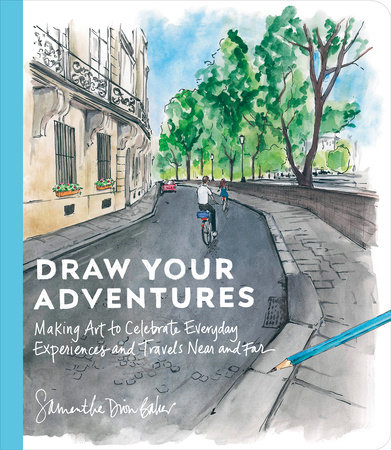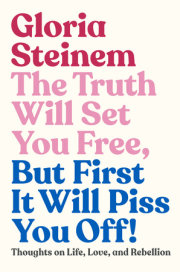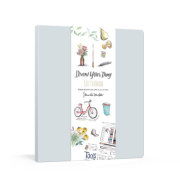IntroductionOne morning, I went to visit my older son at his new apartment in an area of Brooklyn that is not easily accessible by subway. I plugged the address into my GPS and discovered that I could take a bus route I had never been on before and get dropped off a block away.
I boarded the bus in downtown Brooklyn with two bags of groceries and sat there for quite a while as we wound through traffic, stopping and starting, passengers getting on and off. The ride was mostly quiet, but there was a woman across the aisle from me chatting on her phone for the entire thirtyminute trip. She was directly in my line of sight, and I watched the urban backdrop change through the windows behind her as we passed buildings and parks along the way. It suddenly occurred to me that it might be a nice scene to draw in my sketchbook, as a way to remember this first trip to my son’s apartment. I didn’t have my sketchbook on me, so I quickly snapped a photo. As I got off the bus, I noticed that someone had spray-painted “call ur mom” on a wall just a few houses away from my son’s place. It felt like a sign, and I snapped another photo.
My son and I had a really nice visit. We admired his new home, and I helped him organize and fold his laundry. We went out for a late breakfast and then rode the subway together back toward Manhattan, where he was headed to work. It was a very good “mom” moment for me and was definitely a morning to remember.
I tell this story because despite being rather ordinary on the surface, the whole experience was, in effect, an adventure. My end goal was to spend some quality time with my son. But getting there entailed venturing into the unknown: a new travel route, new sights, new people, and a whole new neighborhood.
I have been recording normal, everyday experiences in a sketchbook for years, and deciding what to draw, what will take me back to a particular moment, always excites me. What I ended up drawing in my sketchbook later that day was not the entrance to my son’s new building, his unit’s front door, or even the piles of laundry we folded. Those would have been valid things to record to remember the experience, but instead I chose the unexpected, secondary parts of the experience: the woman seated across from me on the bus, and those spray-painted words on the wall. As I have so often discovered, depicting the smaller moments of a much larger story makes the resulting drawing more interesting and unique.
Even the most ordinary or mundane experiences, such as family time, have the potential to become adventures. It just takes looking through a new lens—or perhaps through multiple lenses.
I have said “Well, that was an adventure!” so many times, either sarcastically or with true appreciation. Sometimes an adventure is obvious, but other times it takes you by surprise.
Not everyone can afford grand travel, nor can everyone physically make big trips. The good news is that you do not have to in order to explore new artistic opportunities. Adventure is literally everywhere and in every moment, if you look for it. Simply by taking a new route to the grocery store you can meet a neighbor for the first time, open your eyes to never-before-seen street signs, or discover a tree you have never noticed before. I may be so bold as to say that opening the wrapper of a piece of gum, chewing the gum, and then discarding it can be an adventure if you let it be.
If you are open to the possibility, even doing piles of laundry on a Sunday afternoon can easily turn into an adventure. The mundane may escalate and unfold into a full-on ordeal—the soap spills all over the floor, or the whites turn pink because of a rogue red sock, or the dryer breaks down so you are forced to hang wet clothes all over your home. Suddenly you have experienced a laundry takeover that can be memorialized through a creative drawing practice. How? You could illustrate the slick wet soap (that might be a fun challenge to depict in a drawing); you could capture the culprit, that one red sock; you could paint swirls of color showing the laundry spinning around and around; or you could draw a full interior rendering of your laundry room (the machines themselves could be a great subject for practicing perspective).
There are also, of course, some adventures that you plan for, save for, and want to savor every moment of. These trips are usually thoroughly recorded with photography, but often these pictures then just sit on our phones or computers. Everything is digital now, from the maps that we use to find our way around to the selfies taken at monuments or museums. One benefit of drawing your adventures is that you will have something other than photographs to look back on to help you remember special moments. Making art forces you to take the time to really look at your subjects and think about the moments you decide to record through drawing, painting, or collaging. Inevitably, you’ll remember those moments on a deeper level.
The art we create gives us a better understanding of our thoughts and feelings. Each drawing deepens our appreciation and perspective of past moments in our lives and helps us achieve more of our artistic goals. Illustrating your adventures allows you to practice making your art while creating something that you and others can look back on for years to come. This book is an invitation to savor moments and capture memories using your eyes, your creativity, and a few art-making tools—no screens needed.
In these pages you’ll find ideas and prompts for motivating your creative brain during your travels—from the grandest faraway adventures to those close to home— as well as suggestions for how to process and draw the days when everything seems to go wrong. Framing adventures, whether good or bad, through a creative practice is the best way to reflect on your experiences, capture your emotions, and most of all be truly present. When you consciously, carefully observe, you are the most open to your creativity. When you draw, you pay more attention, and the more you look, the more creative possibilities you will discover. You don’t have to fly to exotic places to see new and inspiring things. You can find excitement and inspiration in the world around you wherever you are, and my hope is that you will be here for all of it, because there really is so much to draw and paint along your way.
Like my previous books,
Draw Your Day and
Draw Your World, this book is designed to help you see the world around you with new eyes. We’ll look at all the details that make up an adventure, and consider not only what makes a good drawing subject, but also what images will bring you back to a moment you want to remember. It is very important that your subject matter, the colors you choose, the lines you make, and ultimately the art you create bring you joy. A drawing practice will inevitably bring up frustration and our inner critics, but if we learn to balance challenging work with carefree marks and creative play, then each piece we create can be meditative and freeing. Expressing an experience through art should feel good. I hope that this book will help you achieve the deep satisfaction that creating art can bring to your amazing, profound, frustrating, mind-blowing, scary, and sacred adventures.
There is no right way to make art, and there are no rules. I stand by this wholeheartedly. In
Draw Your World, I provide many technical lessons to help people see their subjects with more clarity and understand what is happening with space, composition, proportions, perspective, light, and so on. But these lessons are rough guidelines. I adore artwork that breaks all the “rules” and is pure expression of line or color. I also love work that is closer to reality, and everything in between. What makes a viewer attracted to a piece of art is nuanced and often emotional. I believe that an artwork is successful if you feel something when you look at it. It’s important to remember that great artwork does not necessarily require technical skill. All the artist really needs is confidence, desire to create, and a few materials. Gaining confidence in your own unique art style takes time and patience and is not always linear. Think of your drawing or painting as its own adventure, if you will. The moment you lift your pencil and begin to sketch, the adventure begins. Relax, and be mindful, patient, and gracious with yourself. Like all adventures in life, sometimes a piece of art comes to fruition exactly as you planned, and sometimes what you create is a complete surprise—the adventure unfolding without you realizing how you got there or where you will go next.
As you flip through my examples, remember, too, that I am only one artist, with my own style. There is no way to teach you, my reader, without providing my own examples; just know that my way is not the only right way. My work is spread throughout this book to inspire you with just one way of seeing an adventure and documenting it on paper. I am always thrilled to see all the different ways that people interpret and draw similar adventures in their own lives and styles.
Copyright © 2025 by Samantha Dion Baker. All rights reserved. No part of this excerpt may be reproduced or reprinted without permission in writing from the publisher.

















